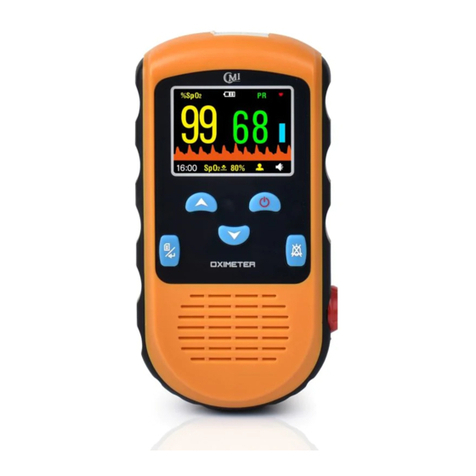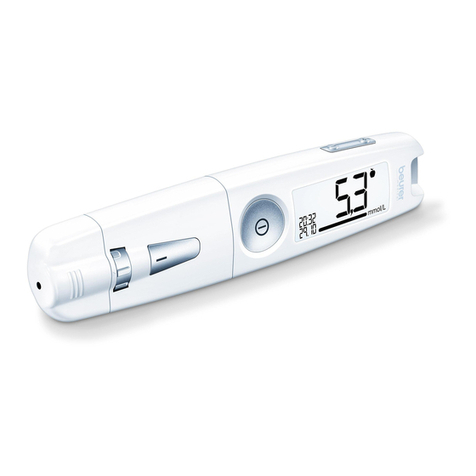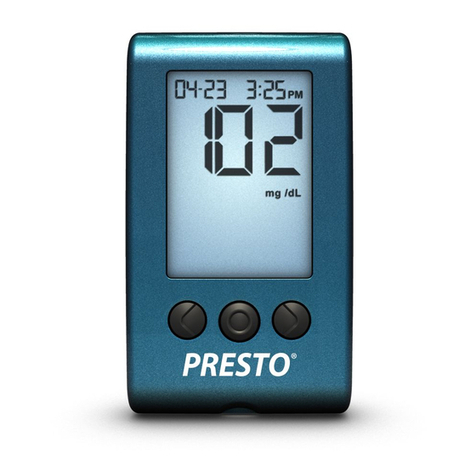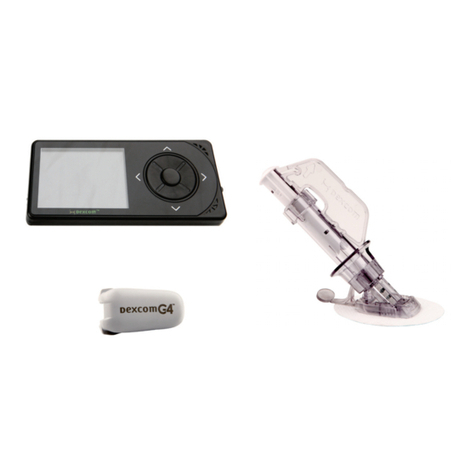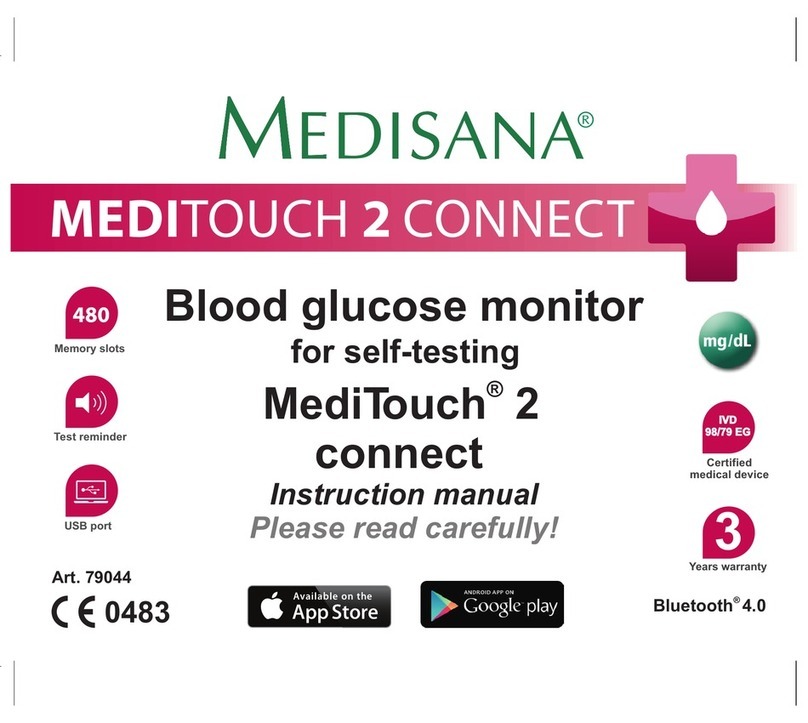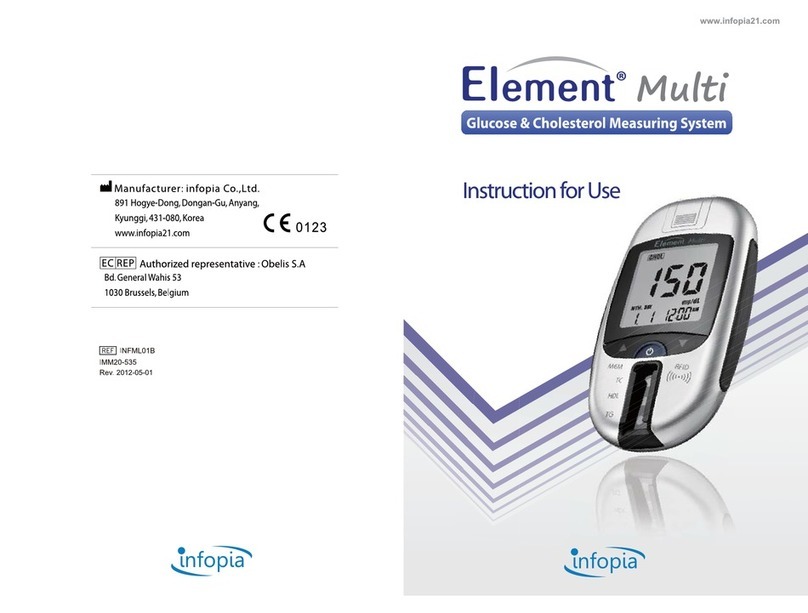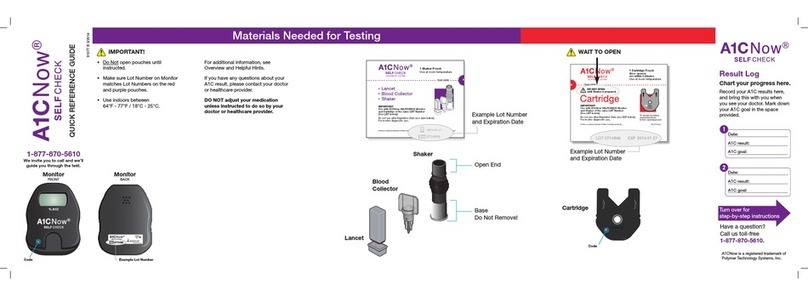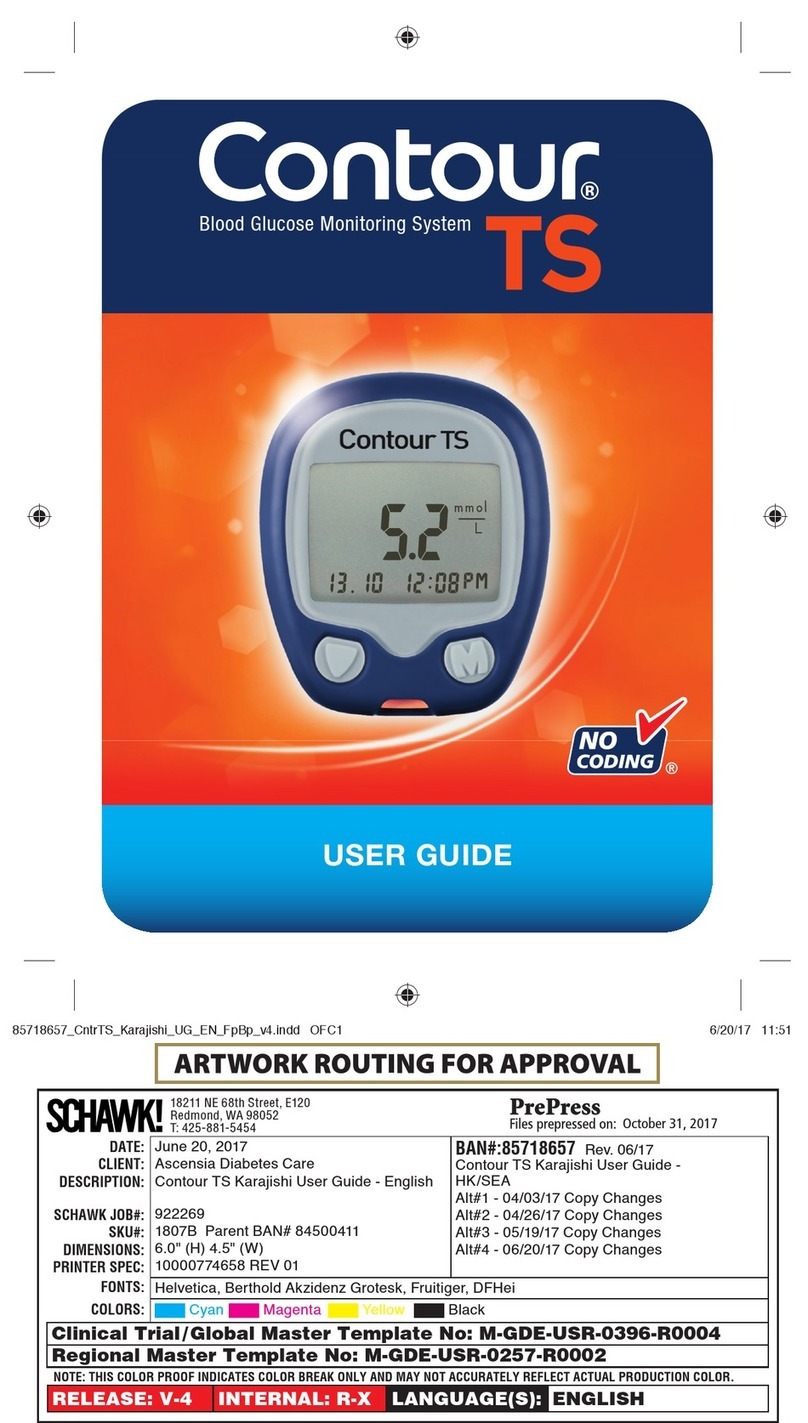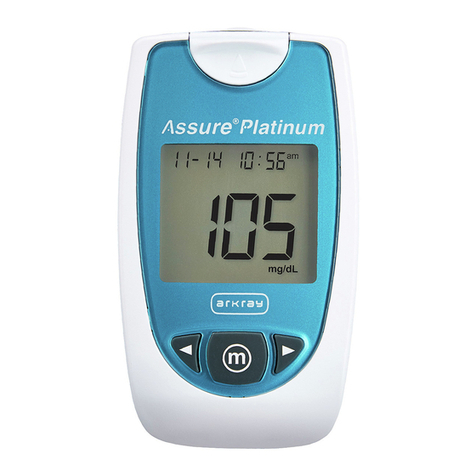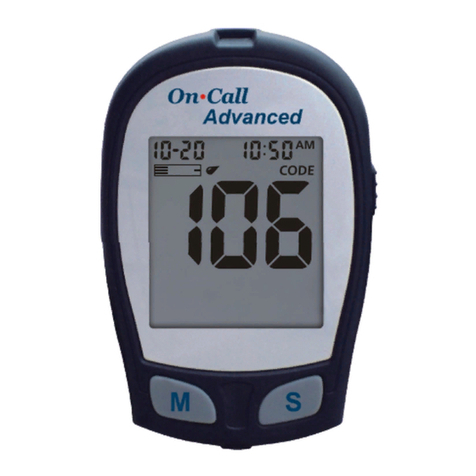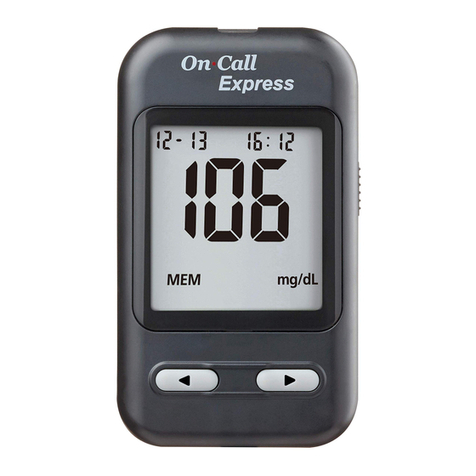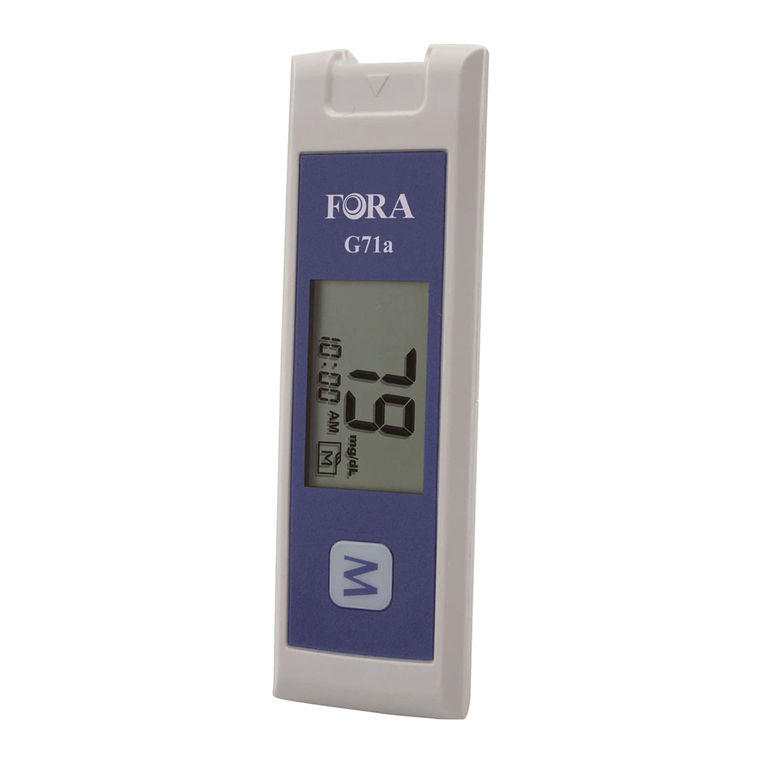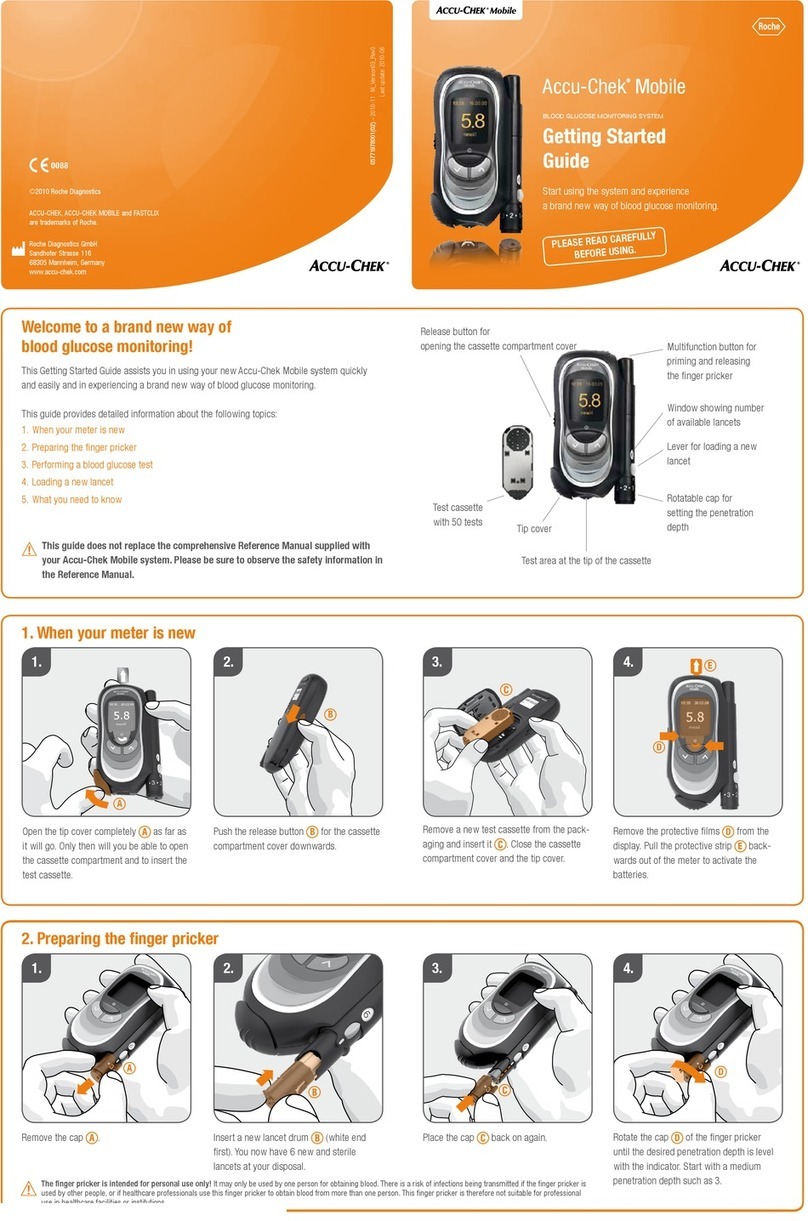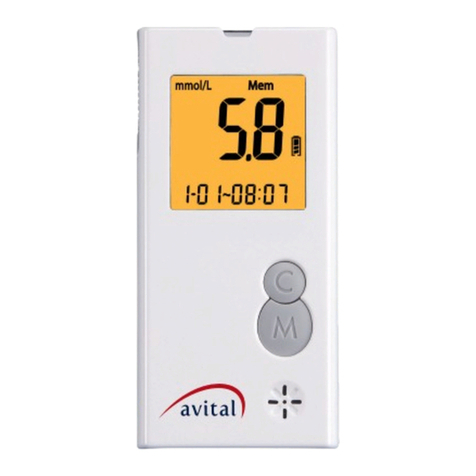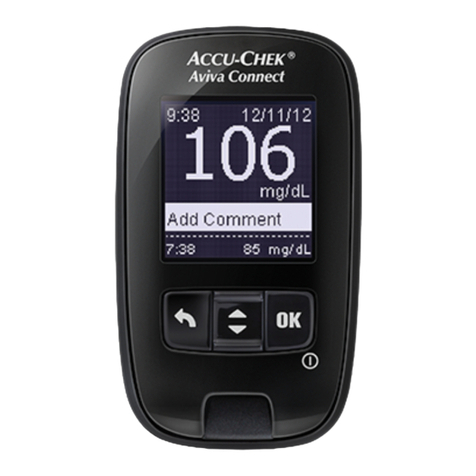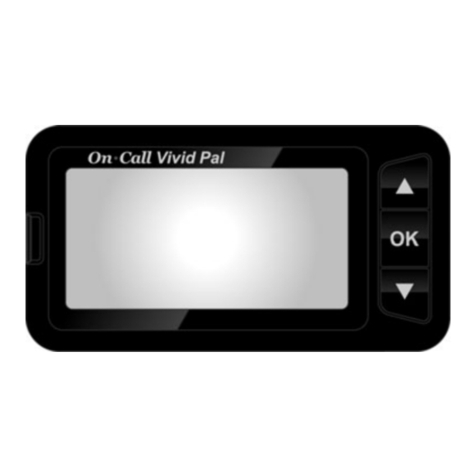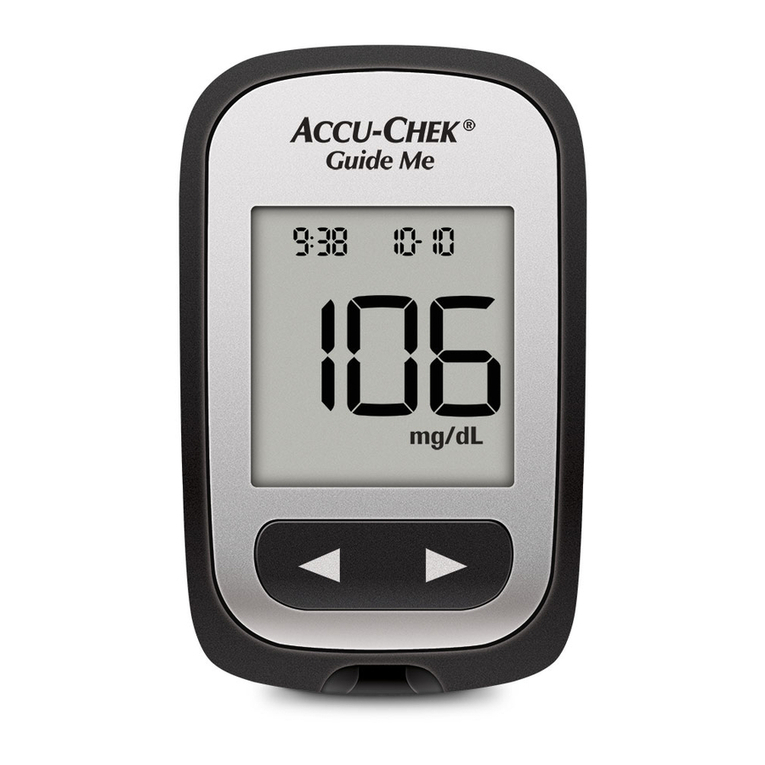CMI Health Smartest Persona II User manual

SIDE
Getting To Know Your System
Contents of the System
This User Guide has been prepared to describe the proper use of the Smartest
Persona II Blood Glucose Monitoring System Model 6276-S. Please read this User
Guide and the package insert that comes with the Smartest Persona II Glucose Test
Strips before testing. The system is available either as a meter alone or as a kit. If you
have a meter only, you can purchase the system supplies from your system provider.
Please provide to your system provider with the 3 digit system reference number
marked on the packaging box when you purchase supplies.
The starter kit of Smartest Persona II Blood Glucose Monitoring System Model 6276-
S includes the following items:
1. Smartest Persona II Glucose Meter with (2) AAA batteries
2. User Guide
3. Carrying Case
4. Smartest Persona II Glucose Test Strips
5. Smartest Persona II Control Solution (Level II)
6. Lancets
7. Lancing Device
8. Package Inserts for Test Strips, Control Solution
A single level control solution (Level II) is provided in the "Starter Kit," and no control
solution is included in the "Meter Only" kit. You may purchase Smartest Persona II
Control Solution Level I, Level II or III from your system provider if needed.
The Smartest Persona II Glucose Meter uses Smartest Persona II Glucose Test
Strips. Neither the meter nor the test strips will work when used with any other brand
of glucose products.
A
SETTING TIME AND DATE
STEP 1. Set the Year
With the meter o, by pressing the M button and hold for 2 seconds,
you will enter the setting modes, press C button to adjust the year
until the desired year is displayed and then press the M button to
conrm the year setting. When pressing the C button, the year will
be adjusted in the range of 2009 to 2029. After the year setting is
conrmed, you will see the month segment ashing on the screen.
STEP 2. Set the Month
Press C button to adjust the month until the desired month is
displayed and then press the M button to conrm the month setting.
You will then see the day segment is ashing on the screen.
STEP 3. Set the Date
Press C button to adjust the day until the desired day appears and
then press the M button to conrm the day setting. You will then see
the hour segment is ashing on the LCD screen.
Model 6276-S
Blood Glucose Monitoring System
USER GUIDE
11-62-8310-0003 V1-OCT21
Meter
DISPLAY :
Shows test results
and messages.
STRIP SLOT :
Insert the test strip here. The
meter will turn on automatically.
"M" BUTTON :
Power ON/OFF, also for memory
recalling mode, please refer to manual
for detailed function description.
STRIP EJECTOR:
Slide the ejector forward
to discard the test strip.
“C” BUTTON :
Setting mode, please
refer to manual for
detailed function
description.
MicroUSB Port:
Cable connection and
data transmitting.
Battery
Compartment :
Area that holds two (2)
AAA alkaline batteries.
Test Strip
ABSORBENT CHANNEL:
Apply a drop of blood here.
CONTACT BARS:
Insert this end into
strip slot.
TEST STRIP HANDLE :
Hold this part to insert the test strip
into the meter slot.
CONFIRMATION WINDOW:
This is where we conrm if enough blood is
applied for has been drawn into strip.
INSTALLING / REPLACING THE BATTERY
The meter comes with 2 AAA alkaline batteries.
Battery life will vary depending on usage, so always keep spare batteries on hand.
Make sure the meter is turned o before changing the batteries.
How to replace the battery
1. Tum off the meter by pressing “M“ button and hold for 2
seconds before replacing the batteries.
Slide down the battery cover on the back of the meter by
pushing the cover in the direction of the arrow and put the
cover aside.
2. Remove the two used batteries
3. Insert 2 new batteries with correct + / ‒ direction.
( Battery: AAA 1.5V 2 Alkaline 24A LR03)
4. Put the battery cover back in place by pushing the cover in
the opposite direction of the arrow to close the cover into
position.
NOTE:
1. It is suggested that batteries need to be replaced when the battery icon appears
empty. If keep using the meter, the battery icon will start flashing and an error
message E_3 will appear on the screen.
2. Note that replacing the battery will not reset the stored testing results.
3. You need to reset the time and date after the batteries are replaced.
4. If there is any unexpected symbol on the display, please follow the above
procedure to replace the batteries again.
5. Please dispose of batteries according to your local ordinances.
LCD Screen Overview
Below is the appearance of the LCD screen:
1. Measurement Units: Appears with the test result
either in mg/dL or in mmol/L.
2. Blood drop icon: Indicates the meter is ready to
take the blood sample when it ashes.
3. Day Average: Indicates current displayed result is
an average.
4. Alarm: Appears when alarm is on.
5. Memory: Appears when you recall the memory.
6. Setting: Appears when you are in setting mode.
7. Test ag: Appears for control solution test ag (c).
8. Battery Symbol: Indicates the battery status.
9. Month
10. Day
11. Hour
12. Minute
1 5
6
7
8
2
3
4
9 10 11 12
STEP 4. Set the Hour
Press C button to adjust the hour until the desired hour appears on
the screen and then press the M button to conrm the setting. You
will then see the minute segment is ashing on the screen.
STEP 5. Set the Minute :
Press C button to adjust the minute until the desired minute appears
on the screen and then press the M button to conrm the setting.
You will then see an “AL” displayed on the screen center.
STEP 6. Set the Alarm Reminder:
Press C button to toggle between the alarm reminder setting or no-
setting mode. If you see the LCD display a small flashing icon of
alarm clock in the lower left corner with a time segment display, it
means that you are in the alarm setting mode.
If you see only AL without the icon of the small alarm clock, it means
that you are not in the alarm setting mode.
Press M button to conrm the alarm setting mode. If you select the
alarm setting mode, alarm clock icon will stop ashing and the hour
of the time segment will start ashing.
Press C button until the desired alarm hour appears and then press
M button to conrm the hour setting. Then the minute segment will
start ashing. Press C button until the desired minute appears on
the screen and then press M button to conrm the minute setting.
You will see the measuring unit ashing on the upper left corner of
the LCD display.
STEP 7. Set the measurement unit:
Press C button to toggle between mg/dL and mmol/L measurement
units. Press M buttonto confirm the setting. You will see a “dEL”
displayed in the center of the screen.
The unit of measurement-mg/dL-is the standard unit of
measurement in the U.S.
STEP 8. Deleting the Memory:
Press C button to toggle between a flashing “dEL” for memory
deletion or a non-ashing “dEL”. If you want to delete all memory,
press M button while the “dEL” is flashing. If you do not want to
delete all memory, press M button when the “dEL” is not ashing.
STEP 9. Power o Screen:
When the meter is off, the time, date, measurement unit, and
battery icon will be still on the screen as the picture If the alarm
reminder has been set, then the alarm icon will appear on the
power o screen as well. The LCD screen will display “OFF”.
Note: Your meter can show results either in “mg/dL” or “mmol/L” units. Mg/dL is the
typical unit used in the United States, please contact the manufacturer if your meter
does not display mg/dL when you turn it on. The factory set default for the meter is
mg/dL.
In the event that the meter loses power or the batteries are changed, the factory
set default is mg/dL. It is very important to use the correct unit of measurement to
properly manage your diabetes. If you live in the United States, you should use mg/
dL. If you are testing in mg/dL, your results will never have a decimal point. If you live
outside the United States and use the metric system, you should use mmol/L.
Your result will ALWAYS have a decimal point.
Note:
1.When you change the date and time backward, you will not change the test results in the meter
memory.
2.You need to move through the year, month, day, hour, minutes, alarm, unit, and dEL to save the
meter settings and turn o the meter.
1.
Before You Begin
IMPORTANT SAFETY INFORMATION
● Please use this device only for the intended use described in this user guide.
● Before using this system to test your blood glucose, please read instructions
thoroughly and practice the test when you first use this system. Do a quality
check on the system by following the instructions and consult with healthcare
professionals for questions or problems.
● Be aware of the safety of young children or handicapped persons near you
when you conduct a glucose test using this system.
● Please keep the test strip vial away from children. The test strips and vial cap
can present a choking hazard.
● Smartest Persona II test strips can only be used with the Smartest Persona II
glucose meter.
Precaution
The meter and lancing device are for single patient use.
Do not share them with anyone including other family members! Do not use on
multiple patients!
All parts of the kit are considered biohazardous and can potentially transmit infectious
diseases, even after all cleaning and disinfection procedures have been performed.
For further information, please refer to below.
FDA Public Health Notication: Use of Fingerstick Devices on More than One Person Poses
Risk for Transmitting Bloodborne Pathogens: Initial Communication” (2010)
http://www.fda.gov/MedicalDevices/Safety/AlertsandNotices/
ucm224025.htm
CDC Clinical Reminder: Use of Fingerstick Devices on More
than One Person Poses Risk for Transmitting Bloodborne
Pathogens” (2010)
http://www.cdc.gov/injectionsafety/Fingerstick-DevicesBGM.html
Intended Use / Indications for Use
The Smartest Persona II Blood Glucose Monitoring System Model 6276-S is intended
to be used for the quantitative measurement of glucose (sugar) in fresh capillary whole
blood samples drawn from the ngertips or forearm. The Smartest Persona II Blood
Glucose Monitoring System Model 6276-S is intended to be used by a single person
and should not be shared.
The Smartest Persona II Blood Glucose Monitoring System Model 6276-S is intended
for self-testing outside the body (in vitro diagnostic use) by people with diabetes at
home as an aid to monitor the eectiveness of diabetes control. The Smartest Persona
II Blood Glucose Monitoring System Model 6276-S should not be used for the diagnosis
of or screening of diabetes or for neonatal use. Alternative site testing should be done
only during steady - state times (when glucose is not changing rapidly).
The Smartest Persona II Test Strips are for use with the Smartest Persona II Blood
Glucose Meter to quantitatively measure glucose (sugar) in fresh capillary whole blood
samples drawn from the ngertips or forearm.
The Smartest Persona II Control Solutions are for use with the Smartest Persona II
Blood Glucose Monitoring System Model 6276-S as a quality control check to verify that
the meter and test strips are working together properly.
● Lancet
Never share a lancet with anyone. Always use a new, sterile lancet; lancets are for
single use only.
● Lancing Devices
Lancing devices should never be used for more than one person. Lancing devices are
re-useable, and the lifetime cleaning does not aect its performance.
● Test Strips
Smartest Persona II Glucose test strips are intended for single use only. They should
be disposed of in an appropriate container according to your healthcare provider’s
instructions.
● Meter
Smartest Persona II Blood Glucose Monitoring System Model 6276-S should only be
used for testing single patient.
● Please test your blood glucose using the meter and the test strips with the same
reference number as labeled on the outer box of meter and the test strips.
Limitations
1. No Neonatal use
Do not use for neonatal blood glucose testing.
2. H ematocrit range
Hematocrit in the range of 32~56% has been shown not to aect the glucose results.
If you do not know your hematocrit level, consult your healthcare professional.
3. Hemoglobin range
Hemoglobin levels of 500 mg/dL or below will not interfere with blood glucose test
results.
4. Elevated Cholesterol and Triglycerides
Cholesterol levels up to 500 mg/dL (12.9 mmol/L) and Triglycerides up to 1000 mg/dL
has been shown not to aect glucose results.
5. Medications
Interference was observed for therapeutic levels of L-DOPA. No interference
was shown for uric acid, acetaminophen, ascorbic acid and ibuprofen in normal
therapeutic levels. However, higher concentrations in blood may cause incorrect
results: Uric acid: >10.9 mg/dL; acetaminophen: > 6.2 mg/dL;
ascorbic acid: > 4.5 mg/dL; ibuprofen: > 37.5 mg/dL.
6. The test strips may be used at altitudes up to 5,280 feet (1,609 m ) without an eect
on test results.
7. Persons suffering from severe dehydration should not be tested using a capillary
whole blood sample.
8. Test results below 70 mg/dL indicate low blood glucose (hypoglycemia). Test results
greater than 240 mg/dL indicate high blood glucose (hyperglycemia). If you get
results below 70 mg/dL or above 240 mg/dL, repeat the test, and if the results are still
below 70 mg/dL or above 240 mg/dL, please consult your healthcare professional
immediately2.
9. Not for use on critically ill patients, patients in shock, dehydrated patients or hyper-
osmolar patients. This meter should not be used in the critically ill.
SIDE
A :
SIDE
B :
1. Getting To Know Your System
2. Prepare For Blood Sampling
3. Performing Blood Test
4. About Alternative Site Testing (AST)
5.Caring For Your System
6. Control Solution Testing
7. Display Messages And Problem-Solving Guide
8. Memory Recall
9. Specifications
10.Download Data
Prepare For Blood Sampling
If your lancing device did not come with a lancing device insert, the following
information shall take the place of the insert.
Adjustable Lancing Device and Lancet
Your lancing device and lancets
are used for obtaining blood
samples from the puncture site.
Important Lancing Device and Lancets Information
1. Lancet is for single use only.
2. Keep lancing device and lancets clean.
3. Use caution when removing the used lancet from the device and when
disposing the used lancet.
IMPORTANT :
1. The meter and lancing device are for single patient use.
2. Do NOT share them with anyone including other family members.
3. Do NOT use on multiple patients.
Protective cap
Setting your Lancing Device
STEP 1:
Insert a new sterile lancet into the Lancet Holder. Push down
rmly until it is fully seated.
STEP 2 :
Twist off the Lancet Protective Cap and save the Cap for
later use. Replace the Lancing Device Cap.
STEP 3 :
The Adjustable Tip offers 10 levels of skin penetration. To
select the desired depth, twist the Adjustable Tip in either
direction until the preferred setting lines up with the arrow. To
select the best depth:
1-3 for soft or thin skin
4-6 for average skin
7-10 for thick or calloused skin
STEP 4 :
Slowly pull back the Cocking Control. You will hear a click,
indicating that the Lancing Device is now loaded and ready
to use.
2.
Lancing
Device Cover
Lancet Carrier
Lancet Ejector
Loading Barrel
Trigger Button
Depth Penetration
CMI Health, Inc.
5975 Shiloh Road Suite 114 Alpharetta, GA 30005 USA
Tel: 1-888-985-1125 Fax: 1-866-222-0128
Email: [email protected]
Website: www.cmihealth.com

SIDE
B
Following is a summary of all Error Messages. These messages help to
identify certain problems,but do not appear in all cases when a problem has
occurred.
Improper use may cause an inaccurate result without producing an error
message or a symbol.In the event of a problem,refer to the information in the
table under Solution.
Problem Error Message Possible Cause Solution
E_1 The temperature
is too low.
The meter is operating in
an ambient temperature
below 10°C or 50°F which
is the lowest range of
operating temperature.
Repeat the test after the meter
and strip are in a warmer
environment and allow the
meter warm up for a while
before retesting.
E_2 The temperature
is too high.
The meter is operating in
an ambient temperature
above 40°C or 104°F which
is the cap of operating
temperature.
Repeat the test after the
meter and strip are in a cooler
environment and allow the
meter sit cooler for a while
before retesting.
E_3 Battery low. The battery is too low to
operate the meter.
Please replace the two AAA
batteries.
E_5 The strip is wet
or used.
The inserted test strip has
been wet or used.
Please check the strip if it is
damaged or used. In either
case, please discard the strip
and repeat the test using a new
strip.
H I
The glucose
level exceeds
the measuring
rangeof the
meter.
The test result is higher
than the measuring range
of 600 mg/dL (33.3 mmol/
L).
Test again following the user
guide for correct glucose
measurement process. If you
see HI again, please call your
medical doctor for advice
immediately.
LO
The glucose
level below
the measuring
range of the
meter.
The test result is lower
than the measuring range
of 20 mg/dL (1.1 mmol/L).
Test again following the user
guide for correct glucose
measurement process. If you
see LO again, please call
your medical doctor for advice
immediately.
NOTE :
Your meter can show results either in “mg/dL” or “mmol/L” units. Mg/dL is
the typical unit used in the United States, please contact the manufacturer
if your meter does not display mg/dL when you turn it on. The factory set
default for the meter is mg/dL.
In the event that the meter loses power or the batteries are changed, the
factory set default is mg/dL. It is very important to use the correct unit of
measurement to properly manage your diabetes. If you live in the United
States, you should use mg/dL. If you are testing in mg/dL, your results will
never have a decimal point. If you live outside the United States and use
the metric system, you should use mmol/L.
Your result will ALWAYS have a decimal point.
For questions related to your health condition, please call your doctor or
healthcare professional.
Performing Blood Test
1. The meter and lancing device are for single patient use. Do not share them with
anyone including other family members! Do not use on multiple patients!
2. All parts of the kit are considered biohazardous and can potentially transmit
infectious diseases, even after all cleaning and disinfection procedures have been
performed.
3. Only the single-use lancing device and lancet should be used with Smartest
Persona II meter.
Smartest Persona II Meter requires a small blood drop to perform a test. You may
obtain your blood sample from a ngertip or forearm. Be sure to wear a new pair of
gloves before obtaining blood sample from each patient. Read the instructions of
lancing device carefully before obtaining blood sample.
Running a Blood Glucose Test
1. Wash hands in warm, soapy water. Be sure to rinse and dry
well. Warm your ngers to increase blood ow.
2. Remove a new test strip from vial and recap the vial quickly and
rmly. While the meter is o, insert a test strip into the meter's
strip slot in the right direction. The meter will turn on with a full
screen display, and a blood drop icon will be blinking on the
screen. If no action is taken in 2 minutes, the meter will turno
automatically.
3. Select and Lance a Puncture Site
*For Fingertip: Hold the prepared lancing device rmly against
the side of your ngertip. Press release button.
*For AST: Please refer to the “About Alternative Site Testing
(AST)” Section. Please consult your healthcare professional
before obtaining blood from site other than your ngertip.
4. Gently massage your finger or puncture site to obtain the
required blood volume. Do not smear the blood sample. To
obtain best accurate result, wipe o the rst drop of blood and
gently squeeze another drop of blood.
90°
5. Apply a small blood drop (● actual size) to the front edge of
the test strip, and the blood should be pulled into the test strip
before the meter begins to count down. Do not push your nger
against the test strip or try to apply a smeared blood sample.
6. The meter will start counting down for 6 seconds and your test
result will be displayed on the screen.
Blood glucose levels normally will vary from time to time
depending on food intake, medication dosages, health, stress
or exercise. Consult your physician or healthcare professional
for the target glucose value appropriate for you. Expected
plasma blood glucose values for normal, non-diabetic, adults
are as follows:
Before Eating: < 100 mg/dL
Two hours after meals: < 140 mg/dL
7. Remove the used test strip by hand or by pushing the ejector
button. The meter will turn off and the test result is stored
automatically.
8.After use, twist o the Lancing Device Cap. Push the exposed
tip of the lancet into its Protective Cap.
Slide the Lancet Ejector forward and disposing the
used lancet in an approved container. Discard the used
lancet according to your country's safety regulations.
Replace the Lancing Device Cap.
9. Wash your hands thoroughly with soap and water after handling
the meter, lancing device, or test strips.
Important:
1. Never reuse a test strip or a lancet. An “E_5” error message will be displayed in the
center of screen if a used strip is inserted into the meter.
2. Discard the test strip and lancet immediately in a puncture-proof container with a lid
after use.
3. If the meter and test strips are moved from one temperature to another, allow
thirty(30) minutes for them to adjust to the new temperature before performing a
blood test.
3
.
Control Solution Testing
About Control Solution Tests
Smartest Persona II control solution contains a known amount of glucose and is used to
conrm that the meter and test strips are working properly. A control solution test should
be performed every time a new vial of test strips are opened, or whenever you suspect
that the meter or test strips may not be functioning properly. For more information about
control solution, please check to control solution insert, thank you.
1. The Control Solution range is found on the bottle of the Smartest Persona II test
strips and NOT the control solution itself.
Note: The ranges in Figure 1 are examples only and not the ranges that you should refer to.
2. Gently roll the control bottle in the palm of your hands as some particles of the solution
may have settled to the bottom.
3. Discard the rst drop as crystallization may occur.
4. Place a drop of the control solution either on a hard surface or the “dimple” of the
control solution cap.
5. Place the meter into “Control” mode when performing a control test so the record do
NOT store in the memory.
How to Perform a Control Test
Always make sure you press C button for Control Solution test, otherwise the control
solution test result will be stored in the memory, and aect your “AVG” results.
IMPORTANT!!!
1. If the meter, test strips and control solutions are moved from one temperature to another, allow
thirty (30) minutes for them to adjust to the new temperature before performing a control test.
2. You must push the C button to distinguish the control solution test from the blood glucose test.
Do not perform the blood test in Control Solution mode. (If you perform the blood test in Con-
trol Solution mode, the test result will not be stored.)
3. Use only Smartest Persona II Control Solution with the Smartest Persona II Glucose Meter.
4. Smartest Persona II Control Solution is used to check that the meter and the test strips are
working together as a system and that you are performing the test correctly.
5. Smartest Persona II Control S olution contains a known amount of glucose that reacts with
test strips. The Level I, Level II and III Control Solutions are intended to check the monitoring
system in dierent measurement ranges.
6. Shake the vial, discard the rst drop of control solution, and wipe o the dispenser tip to en-
sure a good sample and an accurate result.
7. Use only for 3 months after rst opening. Record the open date on the Control Solution vial.
Discard after 3 months.
8. Compare your Control Solution test results with the expected range printed on the test strip
vial label. If your glucose control results fall outside the expected range; repeat the test. Re-
sults that repeatedly fall outside the expected range may indicate:
(1)You may not be doing the test correctly; repeat the test, by shaking the control solution vial well
and carefully following instructions. Please make sure the test is done within the temperature
range.
(2)The Control Solution is expired or contaminated.
(3)The test strips are damaged or outdated.
(4)You may have applied the Control Solution before the blood drop appears on the screen. This
will cause incorrect glucose measurement.
(5)Meter malfunction.
1. Insert a strip into the meter, the last code number saved will
be displayed on the meter, and a blinking blood icon will be
displayed on the screen.
2. Press the C button, and the meter will display a letter “C” on
the upper right corner of screen, indicating the control test
mode. The test result will not be stored in the memory.
3. Squeeze a small amount of Control Solution on a at surface
and apply to the front edge of the test strip.
4. Wait for 6 seconds, and the meter will display the result.
5. Remove the used strips by hand or by pushing the ejector and
the meter will power o with a display of “OFF” on the screen.
Display Messages And
Problem-Solving Guide
Please, treat this meter with proper care, and keep it in good condition. Store your
meter in its case, in a clean dry place at 46~86 ºF (8~30 ºC).
Cleaning and Disinfecting Your Meter and Lancing Device
Cleaning and disinfecting your meter and lancing device is important to prevent the
spread of infectious diseases.
Cleaning is the physical removal of dirt (e.g. dust, grease, and touch contaminants)
from the external surfaces of meter and lancing device. By keeping your meter and
lancing device clean, you help ensure that it is working properly and that no dirt gets
in the device. Cleaning allows for successful, subsequent disinfection.
Disinfection is a process that destroys pathogens, such as viruses and other
microorganisms on the external surfaces of meter and lancing device. By disinfecting
your meter and lancing device, you help ensure that no infection is passed when you
or others come in contact with your meter and lancing device.
Clorox®Bleach Germicidal Wipes (EPA Reg. No. 67619-12) have been shown to be
safe for use with the meter and lancing device and that these wipe should be used
for both cleaning and disinfection.
Cleaning and Disinfection Instructions
We recommend users to clean and disinfect the meter and lancing device at least
once per week. Please keep the meter free of dirt, dust, bloodstain, and water stains.
Using two wipes, follow the cleaning instruction rst and the disinfection instruction
second to clean and disinfect your meter.
Cleaning: Do the cleaning step rst to remove heavy soil and touch contaminants
left on the surface of your meter. Use a germicidal wipe to clean your meter. All
blood and other body uids must be thoroughly cleaned before disinfection by the
germicidal wipe.
Caring For Your System
6.
Specications
Model Name 6276-S
Principle of the test method Amperometric, glucose oxidase
Test Sample Whole blood
Test sites Fingertip, forearm
Measurement time 6 seconds
Code required No code device
Measurement Range 20~600 mg/dL (1.1~33.3 mmol/L )
Batteries 2 x AAA 1.5 V Alkaline 24A LR03
Operating Temperature 10~40 °C (50~104 °F)
Humidity 20~80% R.H.
Dimensions 99 mm (L) x 48 mm (W) x 14 mm (H)
Weight 72 g with battery
9.
7.
Incorrect
Correct
Memory Recall
A. Using the Meter Memory
The test results for blood sample will be stored in the memory automatically. The
meter can store up to 500 of the most recent test results. The control solution
test results will not be stored in memory.
(Note: Please make sure that you press C button when you run a Control
Solution test, so that the control test result will not be added to memory.)
B. Recalling the Test Results from the Meter Memory
1. With meter o, press M button to turn on the meter, the meter
will display the total number of test data stored in memory.
Then the screen will display “001” as the sequential number
of the most recent test result in memory. The memorized test
data will be displayed next. If there is no memorized result in
the meter, “---” is displayed and the meter will turn o after 60
seconds if no action is taken.
(The meter will display “---” if no previous results were memorized.)
2. The screen will display each of the memorized test data in sequence. Press M
and C button to review your test results in memory forwards and backwards.
3. To turn o the meter, press M button for 3 seconds, or the meter will turn o
automatically after 60 seconds of no activity.
C. Displaying Averages in Sequential Order
1. When the meter is o, press C and M buttons simultaneously for 3 seconds to
see the test averages.
2. Navigate through the results using C button and M button.
8.
Download Data
1. Turn on Spot-Check Monitor.
2. Connect Smartest Persona II to Spot-Check Monitor with a cable.
3. Test the blood glucose level following the chapter "Performing Blood Test" in
this User Guide.
4. The test result will be displayed on Spot-Check Monitor.
10.
5.
About Alternative Site Testing (AST)
There are important limitations for doing AST. Please consult your healthcare
professional before you perform AST.
What is AST?
Sampling from anatomical sites (parts of the body) other
than the fingertip to check the blood glucose levels.
This system allows you to test on the forearm with the
equivalent results to ngertip testing.
There are important limitations to AST. Please consult
your healthcare professional before you use AST.
What is the advantage?
It is more painful feeling when taking blood sample from
fingertips because fingertips have many nerve endings.
Other body sites do not have as many nerve endings, so
you will not feel as much pain as at the ngertip.
When to use AST?
Medication, stress, illness, food and exercise can affect blood glucose levels.
Capillary whole blood at the fingertip can reflect test changes faster than
capillary blood at other sites of body. If you test your blood glucose level during
or immediately after a meal, physical exercise or stressful events, take the blood
sample from your ngertip instead of from other sites.
Use AST only :
1. 2 hours or more after taking insulin;
2. 2 hours or more after a meal;
3. 2 hours or more after exercise.
Do not use AST if you are aware that your glucose level is not as stable as usual,
or if you think you have hypoglycemia (low blood sugar) or hyperglycemia (high
blood sugar).
Do not use AST if you think your blood glucose is low and if your AST results do
not match the way you feel.
AST should not be used to calibrate CGMs or in insulin dose calculation.
4.
Disinfection: After cleaning, use a germicidal wipe and thoroughly wet all the surface of
your meter, including the strip lot and other connection ports. Treated area must remain
visibly wet for a full 1 minute. Let the devices air dry completely before turning it on (30
seconds or so).
Do:
* Make sure the meter is in OFF mode during cleaning and disinfection.
* Keep the test strip vial tightly closed when performing the cleaning and disinfection
procedures because the fumes from the disinfectant may aect the performance of the
strip.
* Stop using the devices and contact your customer service if any of the following signs
of deterioration are noted after each cleaning and disinfection cycle:
For meter:
- The meter does not turn on.
- The meter’s screen has been cracked or clouded.
- Any meter’s functions are abnormal.
- Any buttons have stopped working.
For lancing device:
- Any button or moving part has stopped working.
- The device is cracked.
- The device does not yield an adequate blood drop.
Do Not:
* Get any liquid in the test strip slot and other connection ports.
* Spray any cleaning solution directly on to the meter.
* Put the meter under water or liquid.
* Pour liquid into the meter.
Note:
1. If the meter is being operated by a second person who is providing testing assistance
to the user, the meter and lancing device should be cleaned and disinfected prior to
use by the second person.
2. Be sure to wash your hands with soap and warm water, rinse and dry thoroughly after
handling the meter, lancing device or test strips.
Cleaning and Disinfection Frequency
11,000 validated cycles for the meter and lancing device were done; 11,000 cycles
of cleaning and 11,000 cycles of disinfection were included. 5 cycles of cleaning per
day and 1 cycle of disinfection per week allow the user to use the device for 3 year
use life.
Cleaning Frequency:
5 cycles/day x 365 days/year x 3 year use life.
=5475 cycles of cleaning<11,000 validated cycles of cleaning.
Disinfection Frequency:
1 cycle/week x 52 weeks/year x 3 year use life.
=156 cycles of disinfection<11,000 validated cycles of disinfection.
3 year use life for properly cleaning and disinfection.
After 3 years, the meter and lancing device must be replaced with a new meter
and a new lancing device.
To purchase Clorox® Bleach Germicidal Wipes (EPA Reg. No. 67619-12), you can
nd the nearest Clorox Sales Representative at Clorox's global website, http://www.
cloroxprofessional.com/products/clorox-germicidal-wipes/at-a-glance/.
In addition, you can purchase them at
http://www.amazon.com,
http://www.grainger.com/category/cleaning/ecatalog/N-bi4,
or other online retail sites.
This manual suits for next models
1
Other CMI Health Blood Glucose Meter manuals
